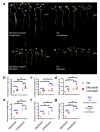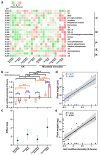Plant and Native Microorganisms Amplify the Positive Effects of Microbial Inoculant
- PMID: 36985145
- PMCID: PMC10055949
- DOI: 10.3390/microorganisms11030570
Plant and Native Microorganisms Amplify the Positive Effects of Microbial Inoculant
Abstract
Microbial inoculants can be used to restore abandoned mines because of their positive effects on plant growth and soil nutrients. Currently, soils in greenhouse pot studies are routinely sterilized to eradicate microorganisms, allowing for better inoculant colonization. Large-scale field sterilization of abandoned mining site soils for restoration is difficult, though. In addition, microbial inoculants have an impact on plants. Plants also have an impact on local microbes. The interactions among microbial inoculants, native microorganisms, and plants, however, have not been studied. We created a pot experiment utilizing the soil and microbial inoculant from a previous experiment because it promoted plant growth in that experiment. To evaluate the effects of the plants, native microorganisms, and microbial inoculants, we assessed several indicators related to soil elemental cycling and integrated them into the soil multifunctionality index. The addition of the microbial inoculant and sterilizing treatment had a significant impact on alfalfa growth. When exposed to microbial inoculant treatments, the plant and sterilization treatments displayed radically different functional characteristics, where most of the unsterilized plant treatment indices were higher than those of the others. The addition of microbial inoculant significantly increased soil multifunctionality in plant treatments, particularly in the unsterilized plant treatment, where the increase in soil multifunctionality was 260%. The effect size result shows that the positive effect of microbial inoculant on soil multifunctionality and unsterilized plant treatment had the most significant promotion effect. Plant and native microorganisms amplify the positive effects of microbial inoculant.
Keywords: microbial inoculant; native microorganism; plant; positive effect size.
Conflict of interest statement
The authors declare that they have no competing interests.
Figures


Similar articles
-
Mineral-solubilizing microbial inoculant positively affects the multifunctionality of anthropogenic soils in abandoned mining areas.J Environ Manage. 2023 Oct 15;344:118553. doi: 10.1016/j.jenvman.2023.118553. Epub 2023 Jul 1. J Environ Manage. 2023. PMID: 37399621
-
Microbial inoculants using spent mushroom substrates as carriers improve soil multifunctionality and plant growth by changing soil microbial community structure.J Environ Manage. 2024 Nov;370:122726. doi: 10.1016/j.jenvman.2024.122726. Epub 2024 Oct 3. J Environ Manage. 2024. PMID: 39366236
-
Microbial inoculants modify the functions of soil microbes to optimize plant growth at abandoned mine sites.J Environ Sci (China). 2025 Aug;154:678-690. doi: 10.1016/j.jes.2024.10.002. Epub 2024 Oct 18. J Environ Sci (China). 2025. PMID: 40049907
-
Plant-soil-microbes: A tripartite interaction for nutrient acquisition and better plant growth for sustainable agricultural practices.Environ Res. 2022 Nov;214(Pt 1):113821. doi: 10.1016/j.envres.2022.113821. Epub 2022 Jul 8. Environ Res. 2022. PMID: 35810815 Review.
-
The Inherent Conflicts in Developing Soil Microbial Inoculants.Trends Biotechnol. 2019 Feb;37(2):140-151. doi: 10.1016/j.tibtech.2018.11.011. Epub 2018 Dec 23. Trends Biotechnol. 2019. PMID: 30587413 Review.
Cited by
-
Biological control of the native endophytic fungus Pochonia chlamydosporia from the root nodule of Dolichos lablab on Fusarium wilt of banana TR4.Front Microbiol. 2024 Mar 27;15:1371336. doi: 10.3389/fmicb.2024.1371336. eCollection 2024. Front Microbiol. 2024. PMID: 38601934 Free PMC article.
-
Meta-analysis reveals the effects of microbial inoculants on the biomass and diversity of soil microbial communities.Nat Ecol Evol. 2024 Jul;8(7):1270-1284. doi: 10.1038/s41559-024-02437-1. Epub 2024 Jun 7. Nat Ecol Evol. 2024. PMID: 38849504
-
Characterization of Different Soil Bacterial Strains and Assessment of Their Impact on the Growth of Triticum turgidum spp. durum and Lens culinaris spp. culinaris.Curr Microbiol. 2025 Mar 17;82(5):199. doi: 10.1007/s00284-025-04171-8. Curr Microbiol. 2025. PMID: 40097641
-
Designing amendments to improve plant performance for mine tailings revegetation.Agrosyst Geosci Environ. 2023 Sep 1;6(3):1-18. doi: 10.1002/agg2.20409. Agrosyst Geosci Environ. 2023. PMID: 38268614 Free PMC article.
References
-
- Zhang J., Xi F. Study on ecological restoration of abandoned mines in China. Acta Ecol. Sin. 2020;40:7921–7930.
-
- Wang F. Occurrence of arbuscular mycorrhizal fungi in mining-impacted sites and their contribution to ecological restoration: Mechanisms and applications. Crit. Rev. Environ. Sci. Technol. 2017;47:1901–1957. doi: 10.1080/10643389.2017.1400853. - DOI
-
- Rothman S.E., Cole C.A., Bruns M.A., Hall M. The influence of soil amendments on a native wildflower seed mix in surface mine restoration. Restor. Ecol. 2021;29:e13440. doi: 10.1111/rec.13440. - DOI
-
- Russell J.E. Soil Conditions Plants Growth. Daya Books; New Delhi, India: 2002.
Grants and funding
- KYCX21_0915/Postgraduate Research and Practice Innovation Program of Jiangsu Province
- 202108320300/China Scholarship Council
- LYKJ[2021]30/Innovation and Promotion of Forestry Science and Technology Program of Jiangsu Province
- 2021ZDLY01/Scientific Research Project of Baishanzu National Park
- PAPD/Priority Academic Program Development of Jiangsu Higher Education Institutions
LinkOut - more resources
Full Text Sources

